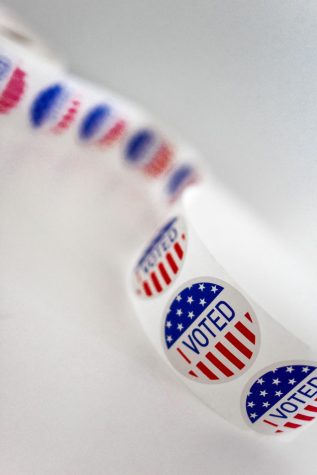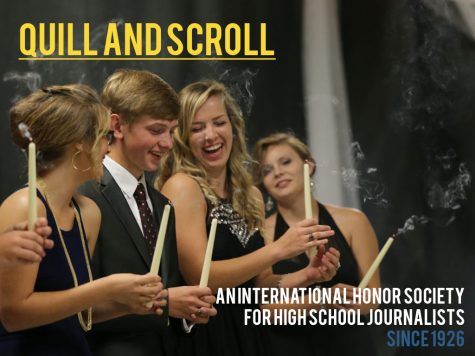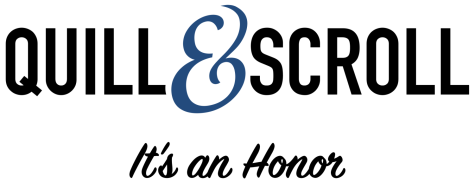THE WEEKLY SCROLL
October 29, 2020
News, tips and advice from Quill and Scroll
The Lede
Unrest in Philadelphia
Monday shooting of Walter Wallace Jr. causes protests, more attention on Pennsylvania
Walter Wallace Jr. was fatally shot by police in Philadelphia Monday after his family called for help with a mental health crisis. Upon arrival at the scene, Wallace was seen holding a knife and did not follow orders to drop the weapon. After raising his arm, police officers fired 14 rounds, killing Wallace. Police officers drove Wallace to the hospital, where he was pronounced deceased.
The identity of the police officers has not been released at this time, but both officers have been moved off street patrol pending investigation. Their names will not be released until officials can verify they do not face potential harm in releasing their information.
Video of the shooting was posted to social media by a bystander.
The shooting gave rise to protest demonstrations in Philadelphia both Monday and Tuesday nights. During the demonstrations, many downtown stores were broken into and two police officers were injured. The National Guard will arrive later this week to protect businesses from further damage.
This all comes at a time where Pennsylvania is already in the public eye; the state has been labeled a key battleground for the 2020 election. Both President Donald Trump and former Vice President Joe Biden have visited the state in the past month as we draw closer to the 2020 election.
The Electoral College

Photo by Element5 Digital on Unsplash
How your vote counts
You may have heard the term “popular vote” before in conjunction with the presidential election. That’s the old one-person-one-vote standard. However, this is not the vote that determines the outcome of a presidential election: that is the Electoral College‘s job.
So, what is the Electoral College?
The Electoral College is a body of representatives, the same as the number of representatives and Senate members in each state, that votes on behalf of the constituents that make up a certain area within their state. There are 538 members of the Electoral College. The job of the Electoral College is to vote on behalf of the citizens that make up their Congressional district; however, their vote is supposed to be cast in favor of the party that wins their state.
Let’s say you live in Iowa: there are four congressional representatives for the state and two senators. That means there will be six votes total that go toward the candidate representing the state’s popular winner. Two states — Maine and Nebraska — apportion their electoral votes according to each district. So in Nebraska in 2008, Barack Obama carried one district and John McCain carried the other two. McCain also got the other two votes from Nebraska — representing its Senate seats — to win Nebraska 4-1.
The number of congressional representatives varies depending on population size which is tallied every 10 years in the U.S. Census.
Thirty-two states require their votes to go to the candidate that wins the popular vote. If electors fail to do this, they run the risk of owing a fine or facing criminal charges.
How are electors determined?
Each election year, political parties in each state nominate candidates that are loyal to party lines to act as electors. There are no specific requirements a state must meet in selecting their electors. Members of Congress cannot be electors.
If an elector’s party affiliation is known, how do swing states come into play?
Because the majority of states require their vote to go to the candidate that wins the popular election, popular votes are incredibly important. More than that, the number of electors for each state can have a large impact on an elections outcome, especially if the state is large, like known swing states Texas and Florida, who hold 36 and 27 congressional seats, respectively.
When will the Electoral College vote be determined in 2020?
On Election Day (November 3) the general election determines what electoral voters will cast their ballot for president. After Election Day, states count the popular vote ballots to certify popular vote results. However, electors do not vote in their state until December 14, 2020.
Why is it important that I vote?
The popular vote determines which electors in your state are chosen. Because electors are based off their loyalty to party lines, your vote (for either major party) is one more vote in count for a certain elector to cast their ballot in favor of your selected candidate.
News outlets as channels for misinformation
Journalists need to prioritize reporting truth rather than covering hot button statements
Here at Quill and Scroll, we’re focused on truth: one of our founding principles. We constantly look for red herrings in news coverage, or informed articles on stopping the spread of misinformation as one of the largest problems and criticisms of journalism today.
Journalist’s Resource author Thomas Patterson wrote a commentary on the misinformation that news media spreads. While we are all aware that untruthful information is stated by public officials, what we don’t talk about is the widespread coverage that information receives. While the coverage may be calling out the information for being untruthful, it also is giving that information airtime – placing the statements in front of the public eye with little to no context.
This imbalance of information may be seen as coverage of newsworthy statements; yet, what does misinformation have to do with the American public when the primary audience of the statement is much smaller than the viewership of news media?
Patterson points to the coverage of President Donald Trump‘s tweets. Every time Trump tweets something that is inaccurate, he receives media coverage. Media coverage exposes people without a Twitter account (those who would not have direct exposure to Trump’s tweets) to false statements: but for what purpose? Because he is the President of the United States, nearly everything he does is newsworthy in some matter, but when that coverage spreads misinformation, is it necessary to be covered?
Covering misinformation attracts viewers. While viewers don’t necessarily know what is going to be covered in the five o’clock news, they can expect the most relevant happenings of the day to be featured. Covering misinformation passes along the information to unsuspecting viewers who may not note the information is false. Once that misinformation is discussed among viewers, it becomes “truth,” because viewers are not sharing that it is false.
The simple solution to this problem is halting coverage on misinformation. The less a topic is covered, the less chance for spread of that misinformation in an unhealthy manner.
“The only effective way for news outlets to fight misinformation is to reduce their contribution.” – Thomas Patterson
In a report for the News America Foundation, political scientists Brendan Nyhan and Jason Reifler suggested specific tactics as a manner of accurate reporting:
- Getting the story right the first time
- Minimizing repetition of false claims
- Making rapid corrections
- Relying on credible sources/Ignoring unreliable ones
- Not amplifying the problem
Not new ideas, eh? Prioritize information that can be verified as true and leave the rest at the door.
It’s An Honor
 Q&S Updates
Q&S Updates
Q&S Board allows non-school chapters to form
The Quill and Scroll Board of Trustees amended its constitution this month to allow non-school organizations to apply for charters and, if granted, to form chapters with the students inducted into the organization. This week, Eye on Ivy, an educational consulting firm based in Pakistan, became the first non-school organization to apply for and be granted a charter. Eye on Ivy works with students who produce content for national, regional and school publications, both in print and online.
We anticipate welcoming other new chapters in places around the world and in the U.S., including local news outlets that publish stories written and/or produced by high school students.
The amended constitution does not change the basic qualifications for induction into the society. Though some schools have more stringent requirements, students need to:
- Excel in the academic arena by earning a 3.0 GPA or by being in the top-third of a student’s class.
- Excel in journalism by doing significant work in a publication, broadcast entity or an online news source.
It’s never too late (or early!) to honor seniors and induct members
If you put off your spring celebrations, you can still induct new Quill and Scroll members and honor seniors this fall. We’re able to take and fulfill orders, even as Quill and Scroll staff work from both our home offices and our offices at the Adler Journalism Building on the University of Iowa campus.
We published this update earlier in August. It includes a simplified order form for schools and advisers willing to pay via credit card, and an offer to host an online induction ceremony for your students. The sooner you induct new members, the sooner they’ll be able start planning chapter activities in the spirit of Quill and Scroll. Here’s a link to a PDF file of the Q&S Chapter Handbook if you don’t already have it.
A reminder about cords:
Students MUST HAVE BEEN OR WILL BE INDUCTED into the Society to earn the honor to wear an Honor Cord (GHC) or Honor Cord with Insignia (GCI). If you order cords for non-members, please choose the Non-Member Cord Option (NCD). Quill and Scroll exists because of the special unifying bond brought about by membership and the lasting legacy of the induction ceremony.
And, as always, feel free to email [email protected] if you have any questions.
Yearbook Excellence Contest closed for entries
Quill and Scroll’s 2020 Yearbook Excellence Contest closed for entries on October 17. We are in the process of distributing over 1,000 entries to our judges.
Winners will be announced in early December. Until then, keep writing!
Writing, Photo and Multimedia Contest is next!
Get ready to start submitting entries for the Writing, Photo and Multimedia Contest starting in December. The final entry deadline will be Feb. 10, but it’s never too early to start looking at your best work and deciding which and how many to enter.
For the first time, the WPM Contest will be split into Class A (large schools) and Class B (not-as-large schools) based on enrollment. That means more chances to earn a first, second or third place. As always, at least 10 percent of all entries will be recognized as winners.
We’ve added three new categories:
- Sports Game Coverage
- Pandemic Coverage (Single Story)
- Pandemic Coverage (Series of Stories)
Here’s where you can find all the categories, as well as last year’s winners.
Director summarizes 2019-2020
If you’re interested in reviewing the 2020-2021 fiscal year, read Jeff Browne’s full annual report, click here.
’60 Minutes’ interview draws nearly 17 million viewers
President Trump walks out, press secretary hand delivers health care plan to interviewer
CBS’ “60 Minutes” episode featuring President Donald Trump and Vice President Mike Pence topped the show’s ratings since their feature on Stormy Daniels, the former pornographic actress who accused Trump of paying her off to stay quiet about their alleged relationship in 2018. As the longest-running prime-time television series, CBS’ “60 Minutes” has hosted a variety of guests that gain national media attention. However, the show often runs alongside NFL’s Sunday Night Football spot that continuously holds the spot for top rankings.
The show was preceded by the “Sunday Night Football” game, which may have added to its viewership, but also stood alongside the MLB’s “World Series” game.
The interview covered Trump’s beliefs of his administration’s COVID-19 response, his appeals to suburban female voters and his plans to end the Affordable Care Act to implement a new healthcare plan.
After Trump preemptively exits the interview with CBS correspondent Lesley Stahl with complaints of unfair questions, White House Press Secretary Kayleigh McEnany handed Stahl a large book that was said to contain the president’s health care plan. However, after inspection, it was revealed the book contained a list of executive orders and congressional initiatives.
British stores banning glitter this holiday season
Attempts to limit plastic pollution may not have large effect on environment
Three major retailers in the United Kingdom (Morrisons, Waitrose and John Lewis) are making an attempt to reduce their production of plastic waste and pollution by eliminating the use of glitter in their holiday merchandise. The brands’ won’t include glitter in the production of any of their own products, but will continue to carry products by other retailers in their stores that use glitter.

Photo by freestocks on Unsplash
Glitter is made of tiny bits of plastic; gift bags, cards, wrapping paper and other decorative holiday gear are covered in the substance every winter, leaving any surface in desperate need of a deep clean after the products have been removed. While we often think of lowering our plastic products use in terms of plastic water bottles, straws and those circular pop-bottle holders, plastic is used in nearly every facet of our lives.. like, glitter.
Yet, glitter isn’t the main source of our plastic problem. In an article examining what the ban on glitter may do for the environment, Bloomberg contributor Adam Minter cites a 2017 study that doesn’t even list tiny plastic particles (one being glitter) as a leading cause of plastic pollution. The study cites substances like glitter making up only 2% of plastic pollution found in the oceans.
While any means to cut back on plastic pollution is important, what are retailers going to do to lessen the effects of leading plastic polluters? Minter suggests that the ban on glitter makes a small environmental impact without drastically changing the operating processes of retailers; even so, their efforts to lessen their plastic pollution is favorable in the eyes of consumers and the media.
The witches are back
‘In Search of the Sanderson Sisters: a Hocus Pocus Hulaween Takeover’ reunites cast members to raise money for NYRP
If you are looking for ways to get in the Halloween spirit this weekend, the New York Restoration Project has the perfect opportunity for you: a Sanderson sister reunion!
Known as the three witches from Disney’s incredibly successful Halloween flick, “Hocus Pocus,” the Sanderson sisters (Bette Midler, Sarah Jessica Parker and Kathy Najimy) are coming together for a virtual Halloween special focusing on the Sanderson family’s history and interviews with special guests like other stars from “Hocus Pocus,” John Stamos, Adam Lambert and Meryl Streep.
Join me! For a marvelous one night only reunion with the Sanderson Sisters and some of our favorite friends – 10/30 at 8pm ET, $10 tix on sale now at https://t.co/NV52KeV8hl pic.twitter.com/UTXtVXzYwm
— bettemidler (@BetteMidler) October 17, 2020
New York Restoration Project is a non-profit organization in New York founded by Bette Midler to create green spaces in under-resourced communities in New York City. It is the only community-wide conservation project that provides healthier outdoor living environments for the members of each burrow. In an interview with Entertainment Tonight Canada, Midler said one of her goals was to provide a green space on every block in NYC.
The event will air virtually Friday, October 30 at 8:00 p.m. EDT. Tickets can be purchased for $10.
Just A Thought
Communities, facts must come before results
By Patrick Johnson, Quill and Scroll board member

Patrick Johnson
A week from today we may not know who the President of the United States will be just yet. As student journalists, you will be one of the most important and significant voices to be sure that your communities understand that.
The closer we get to see which states go red and which go blue, student media must report on the facts within their communities. Localized reporting is necessary for understanding the impact of the election on your towns. While you will ultimately tell the story of the winner and the response to who that is, with fewer local newspapers you are now responsible for giving your community a political voice.
In a time of extreme misinformation, no matter what coverage you choose to do, you must put your communities first by putting the facts first. There will be many people claiming the results exist on Election Day, but that is looking increasingly likely not to be the case. Watch Twitter and other social media outlets like the watchdogs journalism is expected to be; think critically about what is posted and shared; and don’t allow yourselves to get caught up in the conversation about conspiracies, lies and half-truths.
Most importantly, be safe. Animosity is at an all-time high and polarization is some of the most severe in our country’s history. As a journalist, you must be safe. The Committee for Protecting Journalists has a great resource for you to put you and your staffers first–read it.
Here are coverage ideas leading up to Election Day and the waiting period beyond it:
- What are the rules for voting in your community?
- When are deadlines?
- Where can you vote in person?
- What are the requirements to vote in person?
- Does your community have special rules regarding mail-in voting and absentee voting?
- What are the people in your community talking about and why are they talking about it?
- What is on the ballot that directly impacts your community?
- Who is representing your community? Discuss the representatives for Congress that are competing for your community’s vote: what do they offer, what are they promising, and why are they running?
- How has COVID changed your community’s voting behaviors or rituals?
- What does your community need for election night? What does your community need while they wait?
- Help your community to understand the Electoral College, because, let’s face it, it isn’t easy. Here is a quick read from the Harvard Kennedy School to help get you started.
- And if or when the results are unclear, follow this tremendous resource from the Election Coverage and Democracy Network. This offers a comprehensive guide to what could happen and how to cover it if it does. While it is geared toward national media outlets, there is significant importance that our local media report this same information from their towns.
No matter the outcomes, we must work together with our communities to improve news literacy and strengthen our sharing of facts. Remember, journalists: communities and facts first, results later
